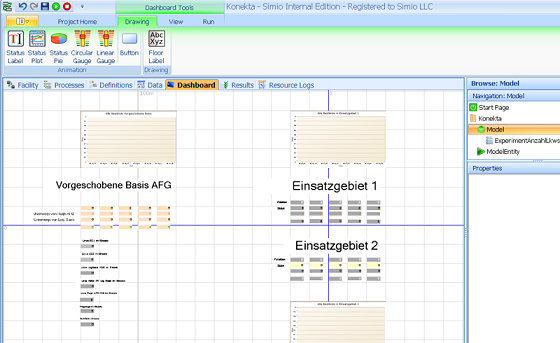With more than 10,000 customers and 800,00 active supply parts, the logistical system of the German armed forces – known as Bundeswehr – is one of the most complex networks in all of Europe.
Given the diverse responsibilities within the armed forces logistics and the variety of internal and external service providers, transparency is particularly important to achieve performance agreement and assessment of results.
In cooperation with the Bundeswehr University in Munich, German Simio partner ATS Prozessoptimierung and Brühl-based Konekta Consulting GmbH utilized Simio simulation software to explore the possibilities of different methods of operations research, specifically the use of simulation to optimize the supply chains of the Bundeswehr.
Key modeling characteristics:
- Ease of use
- 3D animation / visualization of the processes
- Understandability and transparency in the function
- Graphically vivid display of the results achieved
As a COTS (Commercial-Off-The-Shelf) product, in my view, Simio fits perfectly in our first attempts to model the use of the armed forces logistics from Germany to Afghanistan said
The project team chose Simio for its ability to model and optimize supply chains as well as the simulation software's price-to-performance ratio.
With Simio, the entire supply chain can be modeled – from industrial delivery in storage depots to handling in different institutions such as airports, ports, etc.; transportation by ship, aircraft or road and rail; ending with the consumption and the resulting demand.
Nodes can be aggregated and presented in detail as sub-models. This serves as both detailed analysis and training for individual logistic facilities as well as a "business-cross" analysis and optimization of the entire supply chain. Thus, Simio offers the opportunity for the aggregate consideration with connections to the levels of detail of the relevant processes (timing, material objects and data).
The project team relied on Simio’s ability to integrate data for pre-population from many sources, such as Microsoft Excel or CSV files. This data was used “as a basis for simulation and exporting simulation results to definable conclusion of the simulation for the detailed analysis.” See Figure 2.
The simulation is reproducible and speed can be adjusted. On one hand, many different scenarios for several situations with time periods spanning months can be played quickly. On the other hand, it is possible to complete slow repeats for the detailed analysis of critical phases.
Simio provides quantitative, reliable and reproducible results (Figure 3) and supports the careful control and optimization of the overall process instead of sub-optimization of sub-processes. It supports the analysis of impact of process changes, enabling the predictive analysis and planning of response to changing conditions or disorders, which is particularly important to armed forces logistics.
“In my view, Simio allows detailed analysis and individual 'links' as well as an aggregated end-to-end analysis and optimization of complex supply chains of the Bundeswehr. Simio [adheres] particularly well to the supply chain approach," Mr. Konert said.



